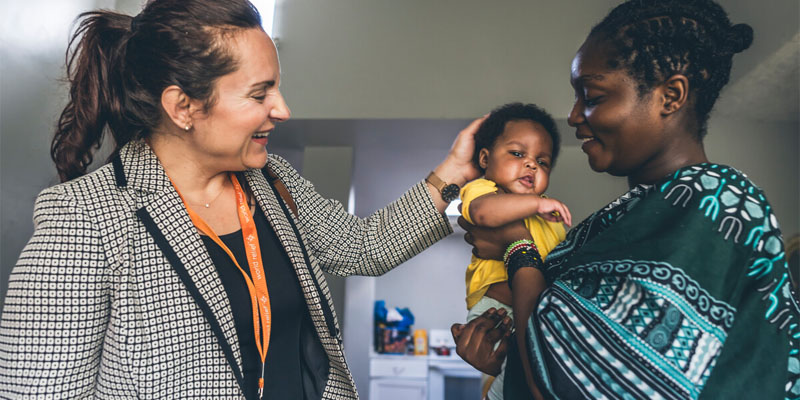[The following videos and blog post are detailed updates we’ve received from Joseph Bataille, World Relief’s Country Director in Haiti, about the relief efforts taking place in Haiti in the aftermath of Hurricane Matthew.]
Every year, my wife and I choose a new part of Haiti to explore for our anniversary. Our country is a gem, full of hidden treasures. And every year, we celebrate by uncovering one of these treasures together.
This past July, we explored Grand’Anse. We began with one of the furthest reaches of the region, Anse d’Hainault. The two and a half hour drive from the entrance of the city of Jérémie was scenic, but to tell the truth, it was a bit exhausting. We had already driven 6 or 7 hours that morning to get to Jérémie. We could only hope that this additional 2.5 hour, slow-paced, rocky trek, would be worth it in the end. After all, we would still have to drive back in a couple of days.
We came up on the main stretch of the town of Dame Marie. It was almost evening and the sun was preparing to set. The colors of the sky dancing and glistening as they reflected off of the sea made us forget all about our uncomfortable drive. The people of the town—not accustomed to receiving many outsiders—each watched from the front porch of their homes as we passed by. Life seemed beautiful and simple. Children played in their yards and in the streets. Men tended to boats and nets after a day of fishing. Women conversed and laughed as they finished various late-afternoon tasks or as they braided each other’s hair, while they relaxed on the front porch. All the while, the sun, the sea, and the sky danced in the background. Beautiful and simple indeed. We took in similar scenes for the last half hour of the drive to Anse d’Hainault.
The rest of our visit in Grand’Anse was equally beautiful. From Anse d’Hainault, we traveled to the city of Jérémie. The family of Alexandre Dumas (author of “The Three Musketeers” and “The Count of Monte Cristo”) hails from Jérémie, as do other notable Haitian writers. This historic city is rightfully known as “The City of Poets.” Traveling further to a hidden cove called “Anse du Clerc.” We sat mesmerized by the crashing of waves into the bay as we drank in beauty that few have the pleasure of seeing. All this while enjoying freshly caught fish served over boiled plantains, and of course, fresh coconuts to drink.
Even more beautiful than the scenery, as usual, were the people that we encountered. We met with our friend and my colleague, Esther, when we traveled back to Jeremie. She showed us around over the next couple of days. Each day, Esther’s aunts fought over the “privilege” of getting to feed us. Every home that we visited had a table prepared; they would hear nothing of the meal that we had just eaten two hours earlier. They showed us around proudly, wanting us to love their town and region at least half as much as they do. They would give us everything, if we would ask, but would receive nothing but good company in return. Each evening we stayed with Esther’s godparents, in their home, set proudly in a Garden of Eden by the sea.
Last Saturday, I visited that place again. The house was still there, and so was the sea, but the garden was gone. So was everything else.
The town of Jérémie was full of piles of debris stacked high. All along the ride through other parts of Grand’Anse, I saw homes that I don’t remember seeing before. Each had lost the trees that had once shielded them from view. Nearly all had also lost their rooftops and many had lost walls as well. With Grand’Anse accounting for a major portion of the nation’s remaining forest coverage, it was devastating to see the hills and mountains, literally stripped bare by Matthew’s winds. At the time, with images coming slowly and rarely, I could only imagine what Anse d’Hainault at the tip of the island might look like in the aftermath. I couldn’t bear to imagine what happened to the people of Dame Marie and their simple and beautiful life.
Nothing was the same in the region. That is, nothing except for the people. Esther’s aunt was excited to see us, yet slightly upset that we surprised her, because she didn’t have a chance to prepare a meal for us. She gently scolded her niece for not calling her in advance (although telephone lines were mostly cut off). Esther’s godparents were still the king and queen of hospitality and, despite the devastation, her godfather still wore his usual smile that you can be sure he’s had on his face since childhood. His wife insisted on preparing a goat for us, despite having lost several goats and their garden in the storm and despite the fact that we had brought our own provisions.
When visiting pastors in Pichon last week, the pastors, who had advance notice of our coming, would already have fresh coconuts ready for us to drink or something else for us to “taste” as we walked along the road. We would look to the few trees that were left standing to see if we could figure out where these gifts were coming from, but we found no sign that there was more to come. We were being offered their best. Their last. Their all. And they refused to be denied the opportunity to be hospitable. Wherever we went, there was a sadness in the air, but over and over we were awestruck by the palpable goodness that remained in the hearts of a people who still wanted to hope.
That same charity and goodness has all but become a national phenomenon. Many miles away, on the first Sunday morning after the storm, churches in the capital were gathered as their usual custom. Surely, the faithful came with the usual personal desires that they wanted to ask God to fulfill, but that day, they also shared a common heaviness. Together, they lifted the burden of those suffering after the hurricane in prayer. Many also began collecting funds and items to send to the victims in distress.
In Les Cayes, that same afternoon, our staff met with a group of pastors, all of whom have churches that have sustained damages. As we discussed with them the importance of preaching the gospel by loving acts, together they resolved to see to that the homes of their more vulnerable neighbors are rebuilt, even if it meant that their church buildings were the last to be repaired. We recently met with a group of pastors in Duchity (Pestel, Grand’Anse) who have agreed to do the same.
Late last week, I participated in a meeting with more than 200 Haitian church leaders in the capital. The purpose was to join together collectively to reach out to the affected areas with short, mid, and long term relief efforts. We had similar conversations with our partners in the capital. All of them excitedly agreed that the primary responsibility for relief must go to the local church. In Belle Anse, church leaders are assessing the damages together, while reflecting on ways to help those who were hit the hardest. Immediately after the storm, some even worked overtime to finish a home that they had begun to build months earlier for a single mother of three. After many months of being stalled by various obstacles, they finished the project in only a few days.
I could fill pages and pages with the difficulties and hardships that are still yet to come. But I would rather put a final exclamation point on what I have attempted say so far…
Haiti has a lot of good things. The best of all these things are its people. Haiti is gold. The Haitian people themselves are diamonds—hard-pressed but not hardened, and refined by many years of adversity. When they pull together, nothing is impossible to them.
The local church is full of such gems, and across the country, near to and far from the disaster, they are pulling together. They are helping one another and looking out for the weakest among them. World Relief is privileged to know some of the best of them. They are a light to their communities. World Relief is working closely with these leaders as they help their communities to recover shelters, gardens, livelihoods, and autonomy. But we refuse to let our work to be the basket that covers and hides the goodness and the light of God’s love that is already present. Rather, we are working in such a way to put that light on the lamp-stand, where it belongs, that the world will see their good works and glorify our Father who is in heaven (Matthew 5:15-16).
The nation is full of people with hearts of servants who are more than ready and more than willing to carry the weight of their vulnerable neighbors. Our job in this time is to help them to find the resources that match the largeness of their hearts and to equip them with skills and knowledge to build back better. Our mission is to help them to accomplish their mission.
That has always been our mission, and it will never change. We empower the church. They seek out the least, the last, and the lost among them, and together we make a world of a difference.
If you have already donated, please consider a second donation to Haiti’s hurricane relief efforts, or a general donation to World Relief’s other work around the world. Also, we invite you to share a link to this page with your friends and family.




